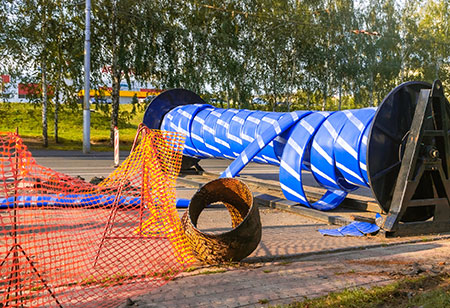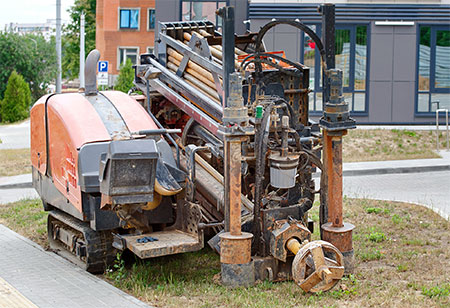
Modern cities face the dual challenge of upgrading aged underground water and sewer pipes while reducing environmental impacts. Trenchless Cured-In-Place Pipe (CIPP) lining presents a solution to these challenges. This method is both practical and efficient, offering a way to repair old pipes without causing harm to the environment.
By adopting this approach, cities can effectively improve their pipe systems. At the same time, they’re making a sustainable choice that reduces environ- mental impact. With this balanced solution, cities can ensure the longevity of their infrastructure and contribute to a healthier planet.
What is CIPP Lining?
CIPP lining is an innovative method that renews pipes without excavation. It’s a trenchless solution, which is ideal for urban areas and sensitive environments. Here’s how it works:
1) Tube Insertion: A resin-saturated felt tube is inserted into the damaged pipe. It fits perfectly within the existing pipe.
2) Tube Inflation: The tube is inflated against the pipe walls using air or water pressure.
3) Resin Curing: The resin in the tube is cured into a smooth, jointless lining within the pipe, typically using UV light or steam.
4) New Pipe Formation: Once the resin hardens, the CIPP forms a tight-fitting ‘pipe within a pipe,’ effectively renewing the pipe’s functionality.
This approach efficiently rejuvenates pipes, contributing to environmental conservation. Here are the benefits it brings to our planet:
Benefit 1: Reduced Carbon Emissions
One significant environmental benefit of CIPP pipe lining is reduced carbon emissions. By restoring pipes instead of replacing them, this method significantly cuts down on carbon usage. Here’s how:
1) Avoiding Pipe Manufacturing And Transport: By reusing existing pipes, CIPP lining eliminates the need to manufacture new pipes and transport them to the site. This directly reduces carbon usage.
2) Minimal Equipment Required: The installation process requires minimal equipment. This cuts down on diesel fuel emissions from heavy machinery typically used in traditional pipe replacement.
3) Preserving Road Structures: CIPP lining allows for the preservation of road structures, eliminating the need for concrete production, which is a significant source of emissions.
4) Short Installation Time: The installation process is relatively quick and doesn’t require traffic diversions. This lessens vehicle idling emissions that often occur during roadwork.
5) Ongoing Pipe Flow Capacity: Once installed, the CIPP lining improves the pipe flow capacity, which lowers energy consumption from pumping.
Using this trenchless solution, cities can improve their pipe systems without adding to their carbon footprint.
Benefit 2: Conserved Raw Materials
Cured-in-place pipe lining goes beyond pipe renewal. It also promotes the conservation of valuable raw materials. Let’s explore how this technology contributes to the preservation of resources:
1) No New Pipe Materials: CIPP lining renews the existing pipe from within, eliminating the need for new pipe materials.
2) Preservation Of Resources: Aggregates, metals, plastics, and chemicals commonly used for new concrete and asphalt can stay in the ground, preserving these valuable resources.
3) Minimized Landfill Waste: Since the old pipe is not discarded, landfill waste is significantly reduced.
 4) Conservation Of Metals And Minerals: The efficient nature of CIPP lining reduces the need for new pumping equipment, thereby conserving additional metals and minerals.
4) Conservation Of Metals And Minerals: The efficient nature of CIPP lining reduces the need for new pumping equipment, thereby conserving additional metals and minerals.
By extending the lifespan of the pipe rather than discarding it, CIPP lining supports resource conservation.
Benefit 3: Preserved Infrastructure
The CIPP trenchless solution is recognized for its role in preserving essential infrastructure. In using this method, there’s minimal disturbance to the surroundings and vital assets.
1) Roadways: Installing CIPP lining does not impact roadways or sidewalks.
2) Utilities: Infrastructure like power and telecom lines located near the pipe remain undisturbed underground.
3) Pipe Systems: Nearby pipe systems stay in service without connections needing replacement.
The preservation of surrounding assets by using CIPP lining provides additional economic and civic benefits.
Benefit 4: Improved Community Sustainability
CIPP lining also supports community sustainability. This trenchless solution has several benefits that contribute to improved community living.
1) Reduced Traffic Congestion: CIPP lining reduces traffic congestion as it doesn’t require street closures and detours. This means less hassle for commuters and residents.
2) Lower Public Costs: The method lowers public costs as it avoids the need for paving repairs and street reconstruction. This can result in significant savings for the community.
3) Avoiding Economic Losses: CIPP lining helps avoid economic losses that can occur from extended utility service disruptions. This ensures that businesses and services can continue to operate smoothly.
4) No Damage To Property: There’s no damage to businesses, parks, or private property above project areas. This helps to maintain the aesthetic and functional value of the community.
By renewing pipes non-disruptively, this trenchless solution helps make cities more livable and sustainable.
Final Thoughts
Trenchless CIPP lining provides the ideal balance of revitalizing infrastructure, protecting the environment, and enhancing communities. By embracing this innovative method, we actively contribute to resolving present-day challenges while paving the way for a more sustainable and eco-friendly future.
We use cookies to ensure you get the best experience on our website. Read more...